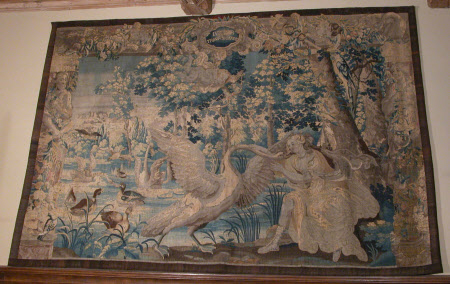Leda and the Swan (Jupiter Transformatus)
Flemish
Category
Tapestries
Date
circa 1660 - circa 1680
Materials
Tapestry, wool and silk, 4-5 warps per cm
Measurements
2570 x 4030 mm
Order this imageCollection
Packwood House, Warwickshire
NT 557842
Summary
Tapestry, wool and silk, 5 warps per cm, Leda and the Swan, Flemish (possibly Brussels), c. 1660-1680. In the foreground Leda sits before a tree on the bank of a river, leaning forward and reaching out towards a large swan (Jupiter) which approaches from the left with its wings outstretched. Cupid hovers above the swan, and an arrow from his bow flies towards Leda. Leda wears a pale yellowish dress and a cloak which billows out behind her, and laced sandals. The background is composed of a wide river with numerous birds flying and swimming, beyond which is a wooded mountainous landscape. The lateral borders are composed of figures of a man and a woman supporting columns with leaves twisting around them, and the top border is made up of garlands of fruit and flowers supported by ribbons and adorned with pairs of cherubs’ heads, a caduceus, and a central cartouche bearing the inscription: ‘IVPITER / TRANSFORMATVS’. There is no lower border.
Full description
The story of Leda and the Swan is recounted in numerous Greek and Roman sources. Jupiter, king of the Gods fell in love with Leda, wife of Tyndareus the king of Sparta, and in order to seduce her he transformed himself into a swan. Leda is shown in the tapestry caressing the swan’s neck as he approaches from a river. Following her union with Jupiter Leda, who had slept with her husband Tyndarus on the same night, gave birth to two eggs, one of which contained the immortal twins Castor and Pollox, and the other Helen of Troy and Clytemnestra. The tapestry comes from a series representing the various amorous conquests of Jupiter, under the collective title ‘Jupiter Transformatus’. Five panels from a different weaving of the series are in Schloss Bruchsal, Baden-Wurttemberg (Southern Germany), representing ‘Leda and the Swan’, ‘the Rape of Europa’, ‘Jupiter and Antiope’, ‘the Deception of Mnemosyne’, and a fragment of ‘Jupiter and Callisto’ (Weinheim 2002, cat. 3, pp. 47-52). Two further tapestries representing ‘Jupiter and Callisto’ and ‘The Rape of Ganymede’, probably from a third weaving of the set, were sold at Piasa, Paris, 23 November 2007, lot 251. The legend ‘IVPITER TRANSFORMATVS’ appears at the top of all these panels, except the Schloss Bruchsal ‘Jupiter and Callisto’ which has lost its borders. Within the National Trust's collection there are two tapestries from the series at Speke Hall, the subjects 'Jupiter and Antiope' and 'The Rape of Europa' (no. 1197405). Like the tapestry at Packwood, they have no lower borders. With the exception of the Rape of Ganymede, all of the episodes depicted in the tapestries occur in book VI of Ovid’s Metamorphoses, in the description of the tapestry woven by Arachne who challenged the goddess Minerva to a weaving competition. The story is one of divine vengeance: Arachne’s tapestry was deemed faultless, and so Minerva punished her for her presumption by transforming her into a spider. Arachne’s choice of subject for her tapestry is evidence of her provocative challenge to the authority of the gods, as all the events she depicted involve the amorous gods deceiving mortals, often by transforming their outer appearance. The theme of Jupiter’s transformations was therefore particularly suitable for a set of tapestries, and Ovid was almost certainly the source. The borders are similar to those on the Schloss Bruchsal, Piasa and Speke Hall tapestries. The man on the left represents Jupiter, holding his attribute of a three-pronged thunderbolt and with an eagle above his head, and on the right is Diana with her bow and arrows. The caduceus which appears in the top and bottom borders is the attribute of Mercury, Jupiter’s son, who assisted him in his seduction of Europa, and the cherubs’ heads and pairs of turtle doves are symbols of love and thus appropriate to the general theme of the set. The origin of the tapestry series cannot be pinpointed exactly. The Schloss Bruchsal set is catalogued as either Antwerp or Bruges, however they may in fact have been woven in Brussels. Similar borders appear on a set of ‘Hunts’ by the Brussels weavers Everaert Leyniers (1597-1680) and Henrich I Reydams (c.1600-1699) and dated c.1645.1650, in the Musées royaux d’Art et d’Histoire, Brussels (Bauer 1977, pp. 85-97). (Helen Wyld, 2009)
Provenance
Bought by Graham Baron Ash in Birmingham before c. 1938; given to the National Trust by Baron Ash in 1941
Credit line
Packwood House, The Graham Baron Ash Collection (The National Trust)
Marks and inscriptions
Jupiter Transformatus (in border above)
Makers and roles
Flemish, workshop possibly Brussels , workshop
References
Packwood House 1931-38: Graham Baron Ash's Scrapbook c. 1931-1938 (557381) Tapisseries bruxelloises du siècle de Rubens, exh. cat. Musées royaux d’art et d’Histoire, Brussels 1977, pp. 85-97 Weinheim, 2002: Tapisserien Wandteppiche aus den staatlichen Schlössern Baden-Württembergs, Schätze aus unseren Schlössern Eine Reihe der Staatlichen Schlösser und Gärten, Baden-Württemberg, vol. 6, Weinheim 2002 , cat. nos. 3a-e, pp. 47-52

